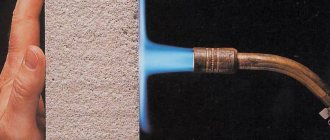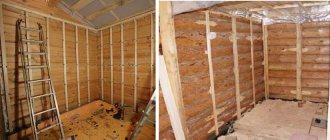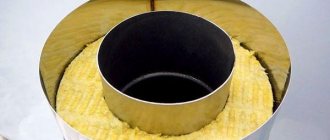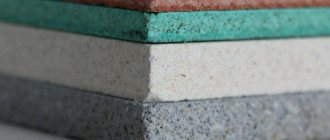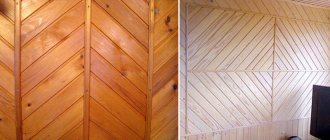The minimal open fires that every home has require careful attention. Non-combustible materials should be used to create comfortable and safe living conditions. Also, the use of fire-resistant boards, sheets or panels is also advisable in places where the presence of fire is not expected, for example in a roofing pie.
This review examines the concept of fire resistance (non-combustibility) in the context of building and finishing materials. Also presented are common non-combustible materials used at various stages of construction.
What is fire resistance of materials
Flammability should not be equated with fire resistance. Fire resistance means the ability of a building structure or material to resist the effects of fire and water in a fire.
The fire resistance limit is the time in minutes (in some cases, hours) from the start of a fire until the structure fails or warms up until the temperature on the surface opposite the fire rises to about 220°C, above which spontaneous ignition of organic materials is possible.
By structural failure we mean:
- Loss of bearing capacity.
- Collapse.
- Achieving irreversible deformations
- Formation of through cracks.
The fire resistance limit of wooden house elements is 15-20 minutes, steel frame ~ 30 minutes.
Combustible building materials are divided into:
| By flame spread over the surface | According to the toxicity of combustion products | ||
| G1 | Low flammable | T1 | Low risk. |
| G2 | Moderately flammable (organomineral materials) | T2 | Moderate danger. |
| G3 | Normally flammable | T3 | Highly dangerous. |
| G4 | Highly flammable (organic materials) | T4 | Extremely dangerous. |
Non-flammable materials include mineral materials: natural stones, concrete and mortars with mineral binders, ceramic and glass materials, metals.
Materials based on organic, plant components are normally and highly flammable . These include chipboard panels, fiberboard, and most synthetic plastic materials.
Low-flammable and moderately flammable are some organomineral materials that do not support combustion: fiberboard, wood concrete, wood impregnated with fire retardants. When exposed to open fire, they smolder, do not give open fire or become charred. Once the source of fire is eliminated, smoldering stops.
When exposed to fire, some organic materials do not produce an open flame, but sinter, melt and saturate the atmosphere with a number of gases harmful to human health. When burned, wood and polystyrene foam emit two types of gases (CO - carbon monoxide, CO2 - carbon dioxide), and plastics - phenol, aluminum oxide, sulfur and other harmful substances.
Main characteristics of refractories
The quality of finished products depends on the characteristics of the material. The key ones are:
- fire resistance;
- thermal resistance;
- chemical resistance;
- degree of deformation at high temperature;
- constancy of volume and shape;
- porosity;
- gas permeability;
- electrical conductivity;
- thermal conductivity.
Let's look at them in more detail.
Fire resistance
It means the ability to withstand elevated temperatures without deformation under the influence of its own weight. When heated, the refractory first softens slightly due to the melting of some of its components. If heating continues, the base material begins to pass into the liquid phase. Interestingly, the complete transition from solid to liquid can occur within hundreds of degrees, so the key characteristic here is the softening temperature.
Thermal resistance
This parameter means the absence of destruction of the refractory material due to a sharp change in temperature, which is important when used in furnaces operating in batch mode. Thermal resistance is affected by thermal conductivity, porosity, grain size, expansion coefficient and some other factors.
To determine the resistance, the prototype is kept at a temperature of 850 °C for 40 minutes, and then cooled in air or first in water and then in air. Then the cycle repeats. The study ends when the mass is lost by 20% (the main reason is the breaking off of individual pieces). The specific value of thermal resistance is equal to the number of cycles sustained before.
Chemical resistance
This parameter refers to the ability of refractory materials to resist destruction from substances that are formed in the melting furnace (dust, slag, metal, gas, steam). The strongest negative impact is caused by slags, which can have an acidic, basic or neutral environment. Based on this factor, all refractories are divided into 3 groups:
- Acidic, containing large amounts of silicon oxide. They withstand contact well with the corresponding slags, reducing and oxidizing gases, but are quickly destroyed by the action of the main slags.
- Basic ones containing lime, dolomite, magnesite and other alkaline oxides. Such refractories, on the contrary, withstand contact with basic slags well, but quickly lose their characteristics when in contact with acidic ones.
- Neutral, containing amorphous oxides (for example, chromium iron ore). Such materials withstand contact with both acidic and basic slags relatively well.
Deformation under load
When lining refractory materials, a compressive force is exerted, which increases with increasing temperature. Severe deformation causes accelerated destruction of the finished coating, so this parameter must be specified. To determine it practically, special tests are used to plot the relationship between temperature and the change in height of the test cylinder.
Constancy of volume and shape
When heated, any substance expands, and when cooled, on the contrary, it decreases in volume. The amount of thermal expansion for most refractory products is minimal, but there are some exceptions. For example, in fireclay bricks and similar products, due to compaction and the formation of a small amount of liquid phase, slight shrinkage occurs, which leads to an increase in the size of the joints in the masonry. Dinas products, on the contrary, expand when heated due to continued recrystallization, which makes the seams even tighter.
Electrical conductivity
This is a key parameter for refractories used to line an electric melting furnace. At normal temperatures, such products act as good quality dielectrics, but when heated, their electrical conductivity gradually increases. The exception is porous refractories, in which the electrical conductivity index, on the contrary, decreases when heated.
Heat capacity
This indicator determines the cooling and heating speed and energy costs. It is important for batch kilns. In practice, the heat capacity of refractories is in the range of 0.8-1.5 kJ/kg × K.
Foam glass is a non-flammable thermal insulation material
Foam glass blocks are made from glass powder that has undergone a sintering process. The chemical composition of foam glass is identical to the composition of classic glass and includes oxides of silicon, calcium, sodium, magnesium, and aluminum.
Foam glass
Foam glass is a completely non-flammable material. It contains no oxidizing or organic components. When foam glass is heated to high temperatures, it only melts (like ordinary glass) without releasing gases or vapors.
The service life of foam glass blocks while maintaining their protective characteristics is more than 100 years.
OLM production
The production of refractory materials begins with the preparation of raw materials. Often workers manually pick out contaminants and impurities from it. Next, the raw materials are crushed and sifted. Then the powder and additives are mixed in strictly defined dosages. The mixture is formatted, dried under natural or special conditions, and fired.
You should understand! OLM are made from natural and artificial raw materials. The most compatible chemical and mineral substances are selected. The structure, density, porosity and strength of the required parameters are formed using a specific technology.
Fireclay heat-resistant bricks
Fire-resistant products differ according to the types of raw materials:
- Organic components. Such products are made from mineral raw materials and are able to withstand significant temperatures. But not all types. For example, expanded polystyrene is characterized by a low resistance to heat and fire, but it can be used to make a stove or fireplace with low heat.
- Inorganic components. This is the largest group of products, the range of fire resistance of which is large. The category includes mineral and basalt slabs, fiberglass, cellular concrete, vermiculite, honeycomb plastic, perlite. The cost of such products is not high - from 300 rubles per 1 m2.
- Composite compositions. This group includes asbestos-based products: asbestos-lime and asbestos-cement materials. This also includes foamed silica products and some others.
Non-flammable wallpaper for walls
Fiberglass wallpaper (glass wallpaper) has fire-resistant properties. The fibers are made from quartz sand, soda, dolomite and lime.
Glass wallpaper
Non-combustible glass wallpaper is intended for finishing all types of buildings and has the following properties:
- The wallpaper is environmentally friendly.
- Convenient to use.
- Does not absorb foam.
- Wallpaper can be washed.
- Material made from fibers perfectly absorbs deformation forces (for example, from plaster).
Using a special self-adhesive tape in the seams when painting, you can completely eliminate the visibility of the seams.
Fiberglass wallpaper is available in both white and colored. They may differ in density, strength, texture and pattern.
Varieties
Non-combustible building materials are classified according to several criteria. By purpose they are distinguished:
- insulators;
- for insulation;
- non-combustible finishing materials for walls, floors, and ceilings.
In addition, the products differ from each other in the way they transfer heat:
- temperature-resistant due to physical and chemical properties;
- materials that reflect heat.
By release form:
- leafy;
- panels;
- roll
By place of use:
- for interior decoration;
- for installation outside buildings and structures.
Important! In addition to the basic fire-fighting properties, fire-resistant products may have additional parameters. For example, moisture resistance allows it to be used in the kitchen, bathhouse or swimming pool. High sound absorption rates allow the material to be used for insulating music studios, cinemas and other facilities.
Fireproof fireproof panels "Gypsoacryl"
Fire-resistant vermiculite boards for walls, roofs and chimneys
Vermiculite boards are fire-resistant materials and have the following properties:
- They are chemically neutral.
- They are inert and do not have alkaline impurities.
- Not subject to corrosion.
- Can be processed with conventional paints and adhesives.
- They do not require any protective measures during installation and operation.
- In fire conditions they do not emit toxic or other harmful substances.
Vermiculite slabs
Such slabs are made by hot pressing from a composition based on calcined expanded vermiculite, liquid glass and inorganic targeted additives, which in the event of a fire provides the highest degree of fire protection for any structures (including metal ones).
During the firing process, vermiculite can increase its volume by 10–15 times. After cooling, the material retains its acquired shape.
Scope of application of vermiculite:
- Fire protection for load-bearing metal structures and air ducts with a fire resistance limit of 0.75-2.5 hours.
- Fire protection of wooden, including load-bearing building structures with a fire resistance limit of 0.75-2.5 hours.
- Increasing the fire resistance of metal air ducts, shafts, casings, sleeves, cable ducts, fire barriers.
- Used in the manufacture of fireproof doors, valves, safes, partitions and suspended ceilings
- It is used for structural thermal protection and fire protection of chimneys during the installation of fireplaces, stoves and other energy equipment.
Fire retardant efficiency group, depending on the thickness of the vermiculite: group 1 (at least 150 minutes) with a material thickness of 48 - 50 mm; Group 2 (at least 120 minutes) with a material thickness of 32-40 mm; Group 3 (at least 60 minutes) with a material thickness of 20-25 mm.
Definition
Non-combustible materials include those that do not ignite under the influence of an ignition source, such as sparks, thermal heating, electric current, or chemical reactions. Natural and artificial inorganic substances are classified according to their origin. Stone blocks, concrete screeds, and reinforced concrete products are considered natural refractories.
Other essential technical requirements for fire-resistant coatings require increased values for the following parameters:
- bending strength, tensile strength;
- hygroscopicity;
- density;
- moisture resistance;
- specific viscosity;
- deformation when heated, wet;
- thermal conductivity.
Additional qualities make it possible to use raw materials for certain tasks.
Scope of application
The purpose of such facing blocks is different. Non-combustible materials are used for finishing walls and ceilings, as well as ceilings and cladding of building facades. They are also in demand for roofing installations, for example from natural tiles. Their physical properties make it possible to install fireplaces, chimneys, and other heating structures.
Note! Since residential, commercial and industrial premises are created for people, finishing materials must also meet environmental criteria and sanitary and epidemiological standards.
Many manufacturers produce product lines that are not only fireproof, but also aesthetically pleasing. Facing and finishing walls perform 2 functions, since their front surface imitates natural wood. They also produce wallpaper equipped with metallized coating and others.
Fireproof substances
Let's consider what substances and materials are non-flammable. The main types of construction consumable components with fire resistance are:
- Fabric - rolled.
- Panel.
Fabric versions of non-flammable materials
Fire-resistant fabrics are an indispensable tool for various construction activities; they are made from these types of raw materials:
- Polyesters. Their fibers are obtained by synthesizing polyester, phosphorus chemicals. Weaving threads are formed using technology from jacquard to velvet fabrics. Their mandatory properties are non-flammability, strength, resistance to ultraviolet and infrared spectrum, and environmental friendliness. When exposed to flame, it shrinks in size, but does not release toxins.
- Carbon. These synthesized fabrics contain exclusively carbon structure. They have increased resistance to fire, chemicals, stretching, deformation and temperature conditions of more than +300 o C.
- Silica and quartz fabrics have similar parameters. The first type of matter is intended for temperatures up to + 2000 o C, the second up to 1300 o C. Quartz threads form something like fiberglass. This type of textile previously served as the basis for spacesuits of Soviet cosmonauts.
- Aramid. Polymer weaving, equipped with transverse and longitudinal stitching. It is manufactured using different methods that determine functionality and heat resistance. Durable fibers can withstand heating up to +370 o C.
- Asbestos. This category of textiles is made from the finest natural silicate fibers, which provides good insulating qualities. Thermal resistance reaches +500 degrees C. However, asbestos boards are not safe for humans, which makes it possible to lay cladding from such layers only for non-residential technical premises. It is suitable for external cladding of boiler rooms, garages, hangars, gazebos, electrical panels, etc.
The catalogs of many brands contain inexpensive fabrics treated with specialized flame retardant solutions. This ensures combustion prevention, and makes them popular for fire-fighting applications. However, such properties are retained for only 1 year; then re-impregnation with special compounds will be required.
Sheet and slab non-combustible materials
Non-combustible finishing materials also come in sheet and tile forms. They are represented by insulating modules, insulation materials, paints and varnishes, decorative panels for interiors and other categories. Some of the most popular and frequently used building materials in slabs and sheets are:
- Cement particle boards are used for assembling the frame of buildings, leveling the base for flooring, and installing partitions. They are fireproof and waterproof.
- Decorative wall panels FIREPROTEC YPL. Eco-friendly modules developed on the basis of gypsum particle boards. Their fastening in kindergartens is allowed. They are characterized by high fire resistance and aesthetics.
- The fender board is a building material coated with HPL, which belongs to the group of flame-retardant materials. The end parts are additionally processed. The appearance can be anything, including the texture of precious wood. The special material simultaneously combines hygiene, fire resistance, moisture resistance, and environmental safety. Installation is possible in children's institutions, buildings and sports grounds, as well as in public places.
- PVTN - vermiculite boards are approved for use in hot production conditions, for example, in metallurgy. In addition to basic characteristics, they are moisture resistant and have a low level of thermal conductivity. Cable lines and cladding of banking and archival buildings are collected from the bottom.
- Fire-resistant gypsum plasterboard is a modified plasterboard with fire-resistant impregnation. It blocks the spread of flame for 30 minutes. The sheet blocks are painted gray and are easy to process.
- Fiberboards do not burn due to their dense structure. They are made using the pressing method from wood fibers with an admixture of cement and specialized additives that have a fire-resistant and antifungal effect.
- SKL panels are a special composite building material. Their composition contains calcium silicate raw materials, which makes the finished product lightweight, durable and environmentally friendly. These non-flammable substances and materials do not change their properties when cold or when heated. They are in demand in the construction of baths, rooms with stoves, and swimming pools. They are characterized by plasticity and resistance to high bending loads.
- Sheets of gypsum fiber facing blocks are durable and resistant to water. These non-combustible building finishing materials are used for installing interior partitions, constructing suspended ceiling systems, and leveling the base for flooring.
The list of which materials are considered non-flammable is also partially specified in GOST 30244.94 and SNiP 21.01.97.
Mineral wool fire retardant products
Mineral wool fibers are able to withstand temperatures above 1000°C without melting. In the process, at temperatures above 250°C, the binders of the material evaporate, and the fibers, due to chaotic adhesion, provide cohesion and sufficient strength, creating protection from fire.
Mineral wool fire retardant products
Mineral wool fire-retardant materials are successfully used for insulating fireplace and stove pipes, external walls, roofs, and floors.
Highly flammable
A group that includes materials, during combustion of which the temperature of the flue gases begins to exceed the threshold of 450 ° C. Flammability class G4 has a degree of damage to the material along the entire length of the sample of more than 85%, a degree of destruction of more than 50%, and independent combustion exceeds 300 seconds.
Additional requirements apply to flammability materials G1 and G2. When burning, they should not form melt drops. An example is linoleum. The flammability class of this flooring cannot be 1 or 2 due to the fact that it melts strongly during combustion.
Magnesium glass panels - a universal fire-resistant finishing material
Magnesium glass sheet is a finishing material based on shavings, magnesium chloride and fiberglass. It is flexible, durable, fireproof and moisture resistant.
The reinforcing fiberglass mesh in the composition allows the glass-magnesium sheet to bend with a radius of curvature of up to three meters. Thanks to this, the material is convenient to use on uneven surfaces without the risk of sheet fracture.
Magnesium glass panels
This fire-resistant material is environmentally friendly. Even when heated, it does not release toxic substances.
Scope of application
Fire-resistant sheet materials are most in demand. Their purpose is determined by the size and set of properties of a specific product. The products are mainly intended for lining stove structures, boiler rooms, fireplaces, chimney ducts, thermal insulation of columns and heating boilers, in baths and saunas. Such protective screens can significantly increase the service life of structures and equipment as a whole, and their individual elements. Powder and molding products are widely used in instrument making to protect devices from temperatures and regulate operating conditions in accordance with technical specifications. Unmolded raw materials are used to produce special clothing, such as equipment for foundry workers.
Non-flammable refractory based on magnesium oxide
Fire retardants to improve fire resistance
Fire retardants are special substances that increase the fire resistance of initially combustible materials.
Basic requirements for fire retardants:
- Preventing combustion and smoldering of the protected material.
- Not capable of causing corrosion of metal parts.
- Ability to act over a long period of time.
- Fire retardants should not increase the hygroscopic properties of wood.
- Harmless to people and animals.
- The compositions should not affect paint coatings or create difficulties during mechanical processing of the material.
One of the best fire retardants is disubstituted ammonium phosphate (diammonium phosphate). When heated, it releases phosphorus oxides, which cover the wood with a protective film, and a non-flammable gas - ammonia. Diammonium phosphate is usually used in a mixture with ammonium sulfate.
There are two types of fire retardant compounds, which are based on fire retardants:
- For deep fire-retardant impregnation of lumber under pressure in industrial autoclave installations.
- For surface fire retardant treatment. This type includes traditional mortars used on construction sites, in attics, on roofs, and rafter systems. The method of application in this case is with paint brushes, rollers, spraying with construction spray guns in two layers with a significant drying period between layers.
Drywall
Another type of non-combustible panels, quite well known both in professional circles and among ordinary homeowners. True, in this case we mean the fire-resistant modification of plasterboard, since in standard versions it refers to a flammable finish. Fireproof boards of this type can withstand up to 20 minutes of direct contact with flame. This figure is far from record values and is difficult to even classify as average, but this drawback is offset by the low price. The fact is that non-flammable materials based on the same calcium silicate are designed to meet high fire safety requirements, and therefore are more expensive. In the case of drywall, you can expect to receive an inexpensive, but visually attractive coating that has basic fire protection.
Fire resistant paint
Fire retardant paint is a mixture of binder, pigment and filler. Such compositions are often prepared using potassium liquid (silicate) glass. Also included in appropriate proportions are fire-resistant fillers, white, colored pigment, potassium liquid glass and special additives. Ground vermiculite, perlite, talc, kaolin wool fibers, and fluffed asbestos are most often used as fillers.
Fire-resistant paint is capable of spontaneous hardening, and the resulting film can serve both for fire protection and for decorative purposes.
Fire-resistant paints on liquid glass are used for interior finishing work and to increase the fire resistance of wooden structures made of fiberboard (fibreboard) and chipboard (chipboard). Organosilicate compositions can be used for painting exterior elements and metal structures.
Brief historical background
The need for fireproof materials arose early in the development of human culture, when fire appeared. Gradually they became the basis of blast furnaces, steel-smelting and other furnaces. In the middle of the 17th century, refractory bricks began to be produced in Russia. During the reign of Peter I, a larger number of them were made on the basis of Moscow clays.
The cladding of the walls around the stove should not only be heat-resistant, but also match the interior of your room
In the 19th century, fireproof production developed only at metallurgical plants, while in Germany it was organized back in 1810, and in Europe they were already producing fireproof products in full swing. With the entry of the bourgeois class into the economic arena and with the development of industry, Russian scientists also began to work in this direction, and in 1893 the Belokamensk, Bryantsevsky and Latninsky refractory clay factories appeared.
In 1929, research on the fire protection of building materials began to be carried out in research laboratories. Fire-resistant paints were invented for wood coatings and intumescent paints for metal. Methods and rules for treating wood with fire retardant compounds are described in SNiP Sh-V.7−69, and GOST 16363–76 established the use of heat-resistant materials for the stove.
Today, out of 212 countries in the world, only 35 can claim to have a refractory industry, and half of the world's production belongs to the CIS and the USA. The importance of refractories in the economy of our country is very great. Without them, the production of many materials, the construction of various thermal units and space exploration are impossible.
Types of substances
It is customary to distinguish three main types of non-flammable substances of different origins. The first type includes solid materials presented in various structural and aggregate states. These can be bulk substances, structures, and individual piece products.
This number includes:
- various rock samples, both hard and softer, including limestone, dolomite, marble;
- concrete and reinforced concrete products;
- loose rocks, including gravel, sand, crushed stone;
- binders - chalk, clay, cement, gypsum, lime, plasters, mortars;
- cast iron and steel products of various types and designs - angles, channels, beams;
- non-ferrous metals, including bronze, copper, brass, aluminum alloys;
- mineral fibers, such as basalt;
- various types of textile materials, including asbestos fabric, basalt fiber;
- regular and fire-resistant glass.
Liquid substances:
- foaming agents and detergents;
- all types and conditions of water, from a drinking source to use as a coolant;
- synthetic liquids that cannot burn;
- acids, alkalis, salts in the form of an aqueous solution.
Gaseous substances:
- carbon dioxide;
- nitrogen;
- freon;
- argon.
How to protect yourself from fire?
Based on all of the above, the following conclusions can be drawn:
- When choosing materials for finishing the facade of a house, it is necessary to take into account their flammability. Highly flammable, fire-hazardous solutions should be avoided.
- The ideal option for finishing a building, from a fire safety point of view, is NG material - non-flammable. It is also allowed to use finishing products belonging to group G1 (low-flammable).
- If there is a need to use a material of group G2 (moderate flammability) in finishing, it is important to use it in combination with mineral insulation (non-flammable stone wool).
- Wet facade finishing technology is considered a reliable solution. In this case, in combination with mineral-based decorative plaster (NG), conditionally non-flammable polystyrene foam (G1) can be used.
- High-quality thermal panels also belong to group G1. However, before buying panels, you need to make sure of their quality and safety. It is better to entrust this task to professionals.
- The use of wood and plastic siding in finishing is unsafe. Natural material requires effective fire protection treatment, and vinyl siding can only be installed with non-combustible insulation.
The best way to protect your house from fire is to entrust the finishing of the facade to experienced builders. We will select suitable materials and ensure their high-quality installation.
